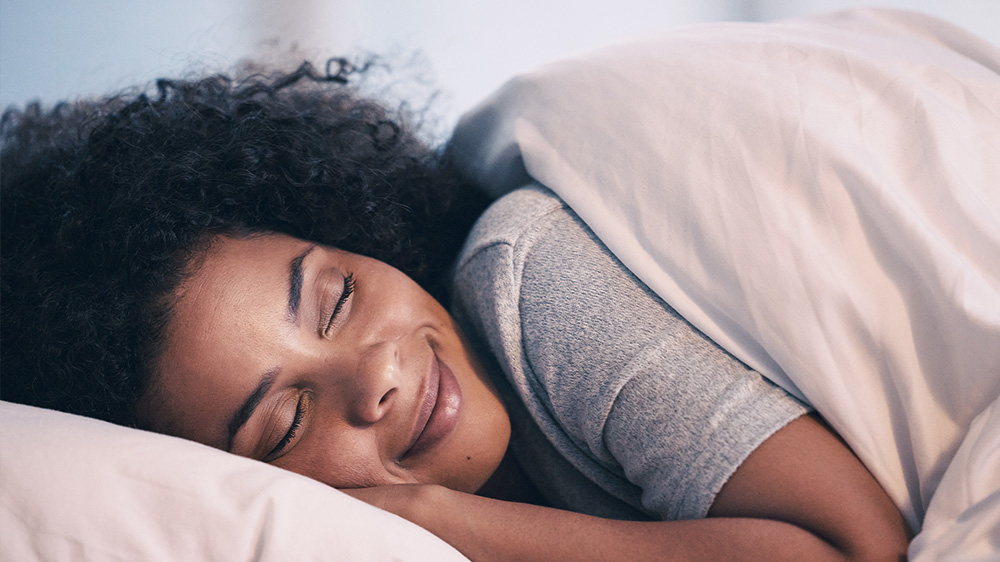The Best Temperature for Sleep
- by Sharon Brandwein
- Updated: May 24, 2024
Table of Contents

While science may never be able to give us a single definitive answer as to why we sleep, one thing is abundantly clear — our bodies are designed to sleep. Each night, our body temperatures drop to help us fall asleep and stay asleep. Our biology is fine-tuned to do the heavy lifting during sleep, but if our sleep space isn’t cool, dark, and quiet, things can go off the rails — quickly. So, what is the best temperature for sleep? It might be cooler than you think.
Note: The content on Sleepopolis is meant to be informative in nature, but it shouldn’t be taken as medical advice, and it shouldn’t take the place of medical advice and supervision from a trained professional. If you feel you may be suffering from any sleep disorder or medical condition, please see your healthcare provider immediately.
Long Story Short
- The temperature of your sleeping space is important, but so is the temperature under the covers.
- The best temperature for sleep is between 62-68°F for most adults. Anything above or below those temperatures may affect your sleep.
- You can optimize your sleep environment by using fans to circulate the air, wearing pajamas made from lightweight, breathable fabrics, and investing in black-out curtains.
What Is The Best Temperature For Sleep?
According to Dan Gartenberg, sleep health advisor, “This is a more complicated question than many people realize because the best temperature for sleep should factor in ambient room temperature as well as the temperature under the covers.”
To accommodate both of the above and sleep comfortably, Gartenberg says that sleepers should “Aim for a cool room, ideally somewhere between 62 to 68°F,” and then fine-tune their “optimal temperature with blankets or pajamas.” (1) Incidentally, he adds, starting off with cooler temperatures can also be “helpful when navigating the different temperature needs between partners.”
And speaking of pajamas and bedding, Dr. Mark Aloia, head of sleep and behavioral sciences at Sleep Number and an associate professor of medicine at National Jewish Health in Denver, Colorado, says, “Heavy bedding or pajamas that retain heat can warm things up too much and interfere with sleep.”
To keep things comfortably cool at night, Aloia says sleepers should reassess their beds, bedding, and other sleep-related textiles for a more personalized sleep environment. For example, he says, there are plenty of mattresses on the market with “temperature-balancing technology to help draw heat away from your body and keep you cool throughout the night.” If a new mattress isn’t in the cards, Aloia says, cooling sheets can do the same, “absorb excess body heat to help you get your ideal internal temperature” — without the blow to your budget.
How Temperature Affects Sleep
“Temperature can either disrupt or support our sleep,” says Aloia. And while 62 to 68°F is a happy medium for most people, temperatures that are too high or too low may stymie your sleep.
What Happens When the Bedroom is too Hot?
Aloia tells us, “If a room is too hot, it can make it more difficult to fall asleep and stay asleep, as it raises your core body temperature when your core wants to drop to its coolest for sleep.”
Beyond making it more difficult to fall asleep and stay asleep, Gartenberg adds, “Comfort is key, and temperatures that are too hot or cold will disrupt sleep quality.” More specifically, he says, “High temperatures can affect your sleep architecture (how you move through the four sleep stages), reducing the amount of time you spend in restorative sleep.” Existing sleep research shows that higher temperatures result in (2)
- Shorter sleep duration
- Less time spent in REM sleep and deep or (slow wave) sleep
- Increased sleep onset latency (the amount of time it takes to fall asleep)
- Sleep fragmentation
What Happens When the Bedroom is too Cold?
While cool temps are typically better for sleeping, Gartenberg warns you can have too much of a good thing here. “A cool bedroom is ideal for sleep, but a room that’s too cold can also disrupt your REM sleep,” he says. (3) “Our bodies naturally experience a slight temperature drop as we fall asleep. If the environment is excessively chilly, it can hinder this process and lead to restless sleep.” (4) We’ll add here that research shows deep sleep may also take a hit when body temperatures drop too low. (3)
What happens if I like a cooler room temperature than my partner?
The thermostat is often a battle between couples, but there may be some solutions to avoid an all-out war come bedtime. For example, the partner that runs chillier might opt for warmer pajamas, or you might try the Scandinavian sleep method, where each person gets their own comforter. This way you can choose the materials that best complement your sleep temperatures and avoid a nightly tug-of-war over your shared comforter!
Does the Ideal Sleep Temperature Change with Age?
“Normally, the ideal sleep temperature stays consistent throughout a person’s life until they reach the age of 65 and older,” says Gartenberg. While he notes that those aged 65 and older tend to sleep better in slightly warmer temperatures (68 to 77 F), Gartenberg cautions that “sleep efficiency may start to decrease when temperatures are above 77 degrees.” And just like their younger counterparts, older adults are likely to spend less time in deep sleep as a result. (5)
At the other end of the spectrum, Gartenberg notes that infants are more sensitive to bedroom temperature changes, something worth considering for parents. According to Gartenberg, “The best sleep temperature for infants is somewhere between 68 and 72 degrees F.” (6)
The main caveat for parents is that babies can’t regulate their body temperatures as well as adults. “A room that is too cold for the infant can bring their body temperature too low, and a room that is too hot can increase the risk of SIDS, especially if the baby is sleeping in warm clothing,” says Gartenberg. (7)
Tips for Keeping Cool at Night
“By creating a cooler and more comfortable sleep environment, you’ll be setting yourself up for a better night’s rest and to feel more energized in the morning,” says Gartenberg. To optimize temperatures in your sleep space, the experts recommend the following.
Keep Your Sleep Space Cool and Dry
Gartenberg suggests incorporating things like dehumidifiers and box fans to circulate air and help maintain a cool, dry space that promotes your body’s natural temperature regulation.
Change Your Clothing
“Consider switching to very light pajamas made from breathable fabrics like bamboo,” says Gartenberg. “These materials allow for better airflow and prevent you from trapping heat close to your skin, ensuring a more comfortable and restful night’s sleep.” (7)
Time Your Workouts and Warm Baths Appropriately
Aloia says, “Lifestyle choices, hormonal changes, medications, and anxiety can also boost your body temperature,” so sleepers should keep that in mind if exercise and baths are a regular part of their sleep hygiene protocol. (8) (9)
Exercise can increase your metabolic rate and body temperature. (10) While light exercise before bed may be fine, Aloia suggests avoiding vigorous exercise before bed — this gives your body ample time to cool down for sleep. (11) Similarly, Aloia advises timing warm baths one to two hours before bed to reap the benefits of the cool-down effect, not immediately before sleep. (12)
Try Blackout Curtains
Good sleep hygiene tells us that our sleep environment should be cool, dark, and quiet. And while most people may not realize it, blackout curtains are a great investment because they can check off all of those boxes. During hot weather, blackout curtains can efficiently block out light and reduce internal-to-external energy transfer, which also helps to keep temperatures down. And during the winter months, Gartenberg notes, “Thick curtains act as an insulator, trapping heat within the room and creating a more comfortable sleep environment.”
FAQs
Is it better to sleep cold or warm?
The best average temperature for most adults to sleep is somewhere between 62 and 68°F. Sleeping in hotter or colder temperatures can disrupt both the duration and quality.
Does the ideal sleep temperature change by season?
“An ideal room temperature doesn’t change with the seasons,” says Alois. “It may be tempting to turn your AC or heat up depending on the time of year and weather, but the same temperature is effective for sleep year-round.”
The Last Word From Sleepopolis
The best temperature for sleep is cool but comfortable — anything outside the recommended 62 to 68 F, and your sleep can take a hit in both duration and quality. To ensure you get the sleep you need night after night, optimize your sleep space, and don’t forget to adjust the thermostat.
Sources
- Cleveland Clinic. (2024, April 30). What’s the best temperature for sleep? https://health.clevelandclinic.org/what-is-the-ideal-sleeping-temperature-for-my-bedroom
- Zheng G, Li K, Wang Y. The Effects of High-Temperature Weather on Human Sleep Quality and Appetite. Int J Environ Res Public Health. 2019;16(2):270. Published 2019 Jan 18. doi:10.3390/ijerph16020270
- Herberger, S., Penzel, T., Fietze, I. et al. Enhanced conductive body heat loss during sleep increases slow-wave sleep and calms the heart. Sci Rep 14, 4669 (2024). https://doi.org/10.1038/s41598-024-53839-x
- Szymusiak R. Body temperature and sleep. Handb Clin Neurol. 2018;156:341-351. doi:10.1016/B978-0-444-63912-7.00020-5
- Baniassadi, A., Manor, B., Yu, W., Travison, T., & Lipsitz, L. (2023). Nighttime ambient temperature and sleep in community-dwelling older adults. Science of The Total Environment, 899, 165623. https://doi.org/10.1016/j.scitotenv.2023.165623
- Burns, C. E., Dunn, A. M., Brady, M. A., Starr, N. B., Blosser, C. G., & Garzon, M. D. L. (2012). Pediatric primary care – E-book. Saunders.
- Bach V, Libert JP. Hyperthermia and Heat Stress as Risk Factors for Sudden Infant Death Syndrome: A Narrative Review. Front Pediatr. 2022;10:816136. Published 2022 Apr 15. doi:10.3389/fped.2022.816136
- Baker, F. C., Siboza, F., & Fuller, A. (2020). Temperature regulation in women: Effects of the menstrual cycle. Temperature, 7(3), 226–262. https://doi.org/10.1080/23328940.2020.1735927
- Layton JB, Li W, Yuan J, Gilman JP, Horton DB, Setoguchi S. Heatwaves, medications, and heat-related hospitalization in older Medicare beneficiaries with chronic conditions. PLoS One. 2020;15(12):e0243665. Published 2020 Dec 10. doi:10.1371/journal.pone.0243665
- Périard, J. D., H. Eijsvogels, T. M., & M. Daanen, H. A. (2021). Exercise under heat stress: Thermoregulation, hydration, performance implications, and mitigation strategies. Physiological Reviews. https://doi.org/PRV-00038-2020
- Stutz J, Eiholzer R, Spengler CM. Effects of Evening Exercise on Sleep in Healthy Participants: A Systematic Review and Meta-Analysis. Sports Med. 2019;49(2):269-287. doi:10.1007/s40279-018-1015-0
- Haghayegh, S., Khoshnevis, S., Smolensky, M. H., Diller, K. R., & Castriotta, R. J. (2019). Before-bedtime passive body heating by warm shower or bath to improve sleep: A systematic review and meta-analysis. Sleep Medicine Reviews, 46, 124-135. https://doi.org/10.1016/j.smrv.2019.04.008
Aloia, Mark. Author Interview. May 9, 2024.
Gartenberg, Dan. Author Interview. May 8, 2024.
Subscribe Today!
Get the latest deals, discounts, reviews, and giveaways!
